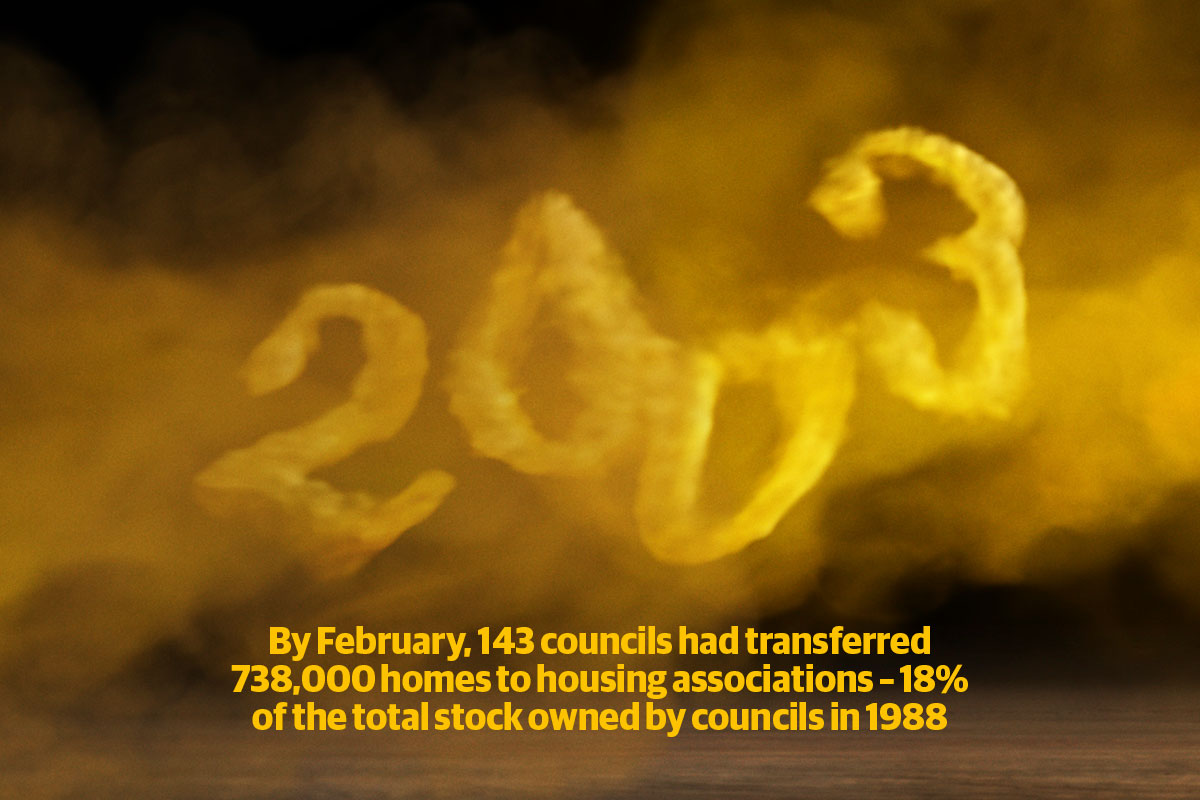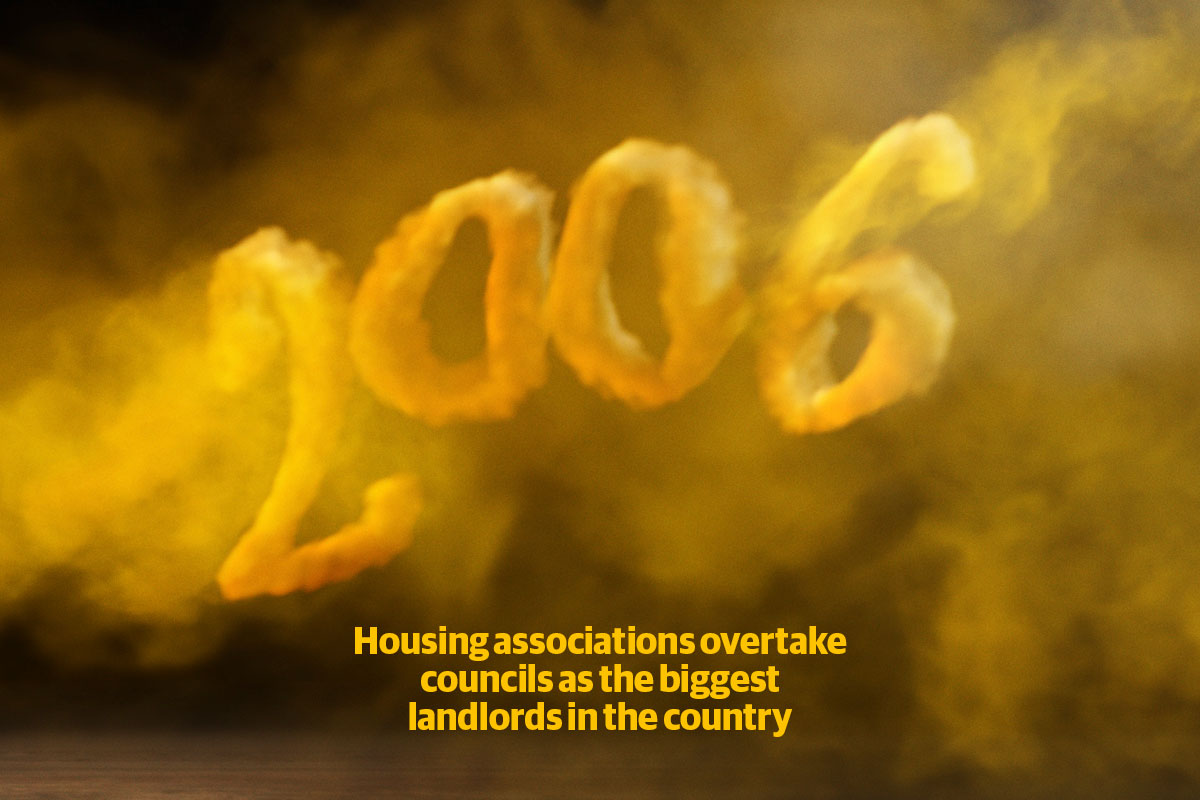You are viewing 1 of your 1 free articles
Thirty years on: how the Housing Act changed everything
The Housing Act 1988 has been described as ‘year zero’ for housing associations and one of the key moments that created today’s market. But why does one piece of legislation have such a profound legacy? Gavriel Hollander finds out. Illustration: Peter Crowther Associates
History, so the old saying goes, is just one bloody thing after another. Some of those bloody things, however, have more longevity than others.
For the housing sector, an act of parliament that came into force 30 years ago last week is one such thing.
The Housing Act 1988 transformed the sector and – argue some – was the catalyst for much of what has happened since. Mega-mergers, 100,000-home housing associations, stock transfers, new rent products, the erosion of tenants’ rights – all of these have their roots in 1988.
Inside Housing has gone back in time and spoken to a number of senior figures who were working in the sector in the 1980s to find out what the act involved, how it was viewed at the time, and to ask what its legacy is today.
“The 1988 act was part of a bigger picture, that it was decided that housing associations were going to be the next big thing" John Perry
“It was ‘year zero’, really,” remembers John Bryant, policy leader at the National Housing Federation, who was working at co-operative housing provider CDS in Stockwell, south London, in 1988. “It was a hugely ambitious and important piece of legislation and I think it was seen as such at the time.”
Brought in by Conservative environment secretary Nicholas Ridley, the act broadly had three strands that – when combined – helped to create the modern-day housing market and gave rise to the housing association sector we see today. These were: the introduction of private finance – or ‘mixed funding’ – for housing associations; provisions to ease the passage of stock transfer from local authorities to housing associations; and the deregulation of private rent and the scrapping of lifetime tenancies.
“The 1988 act was part of a bigger picture, that it was decided that housing associations were going to be the next big thing,” says John Perry, who was working at Leicester City Council at the time and is now senior policy advisor at the Chartered Institute of Housing (CIH).
No one, however, could have guessed quite how big.
“It would have been astonishment,” answers Mr Perry, when asked how people might have reacted if they were told at the time that housing associations would one day own 100,000 homes or more. As one senior figure in the sector remembers, an association of 5,000 homes was “considered elite”.
But what was it that meant the landscape could change so dramatically within a decade-and-a-half? In short, the widespread adoption of stock transfer by councils and the widening of funding options for housing associations created an uneven playing field when it came to the relative capabilities of the two to build homes.
Although the idea of councils transferring stock to newly formed housing associations had been around for at least a couple of years before the act, its take-up was limited. Few town halls took the option, with Chiltern District Council a famous exception.
The introduction of ‘voluntary transfer’ changed that, with a system of tenant ballots brought in under which even those who voted against transfer would find themselves with a new landlord if the majority voted ‘yes’.
Meanwhile, housing associations were given new powers to borrow from the private sector, breaking their traditional link to grant funding and giving them a competitive advantage over local authorities.
“Clearly stock transfer had a great impact, but mixed funding might have had a bigger impact,” says Tom Murtha, former chief executive of Midland Heart. “There was a campaign within the sector against mixed funding, because even then we thought it would bring about a reduction in grant, and lo and behold 30 years later grant is down to whatever it is down to. You can trace that directly back to the introduction of mixed funding.”
As the act was making its way through parliament in 1988, Mr Murtha was taking up his first executive director job in the sector, at Merseyside Improved Houses, now part of 56,000-home Riverside.
Indeed, the eventual merging of small, community-based organisations into housing associations spanning huge swathes of the country and with tens of thousands of homes seems to have been an unintended consequence of the stock transfer process.
Mr Murtha continues: “If anyone had said this would lead to the biggest transfer of social housing stock we’ve ever seen – and would eventually lead to organisations like Clarion – no one could have envisaged that.
“There was a campaign within the sector against mixed funding, because even then we thought it would bring about a reduction in grant, and lo and behold 30 years later grant is down" Tom Murtha
“It’s interesting that one of the reasons given for stock transfer was that local authorities had become too big and so one of the ways to break them up was to transfer them to housing associations, and now some are bigger than any local authorities were in 1988.”
Mr Murtha is one of a number of sector figures Inside Housing speaks to who question whether the growth that started with the 1988 act has meant housing providers have lost touch with the communities they once served.
“Lots of big organisations are driven more by commercial purpose than their social purpose,” he asserts. “Lots of people feel that’s part and parcel of that drift away from their communities.”
Mr Murtha believes that the fact that stock transfer did not involve the transfer of responsibility for housing people from councils to housing associations has had other profound consequences.
“I’d argue that one of the reasons we have a huge problem with homeless people today isn’t just because of welfare benefit reductions, but actually because no one who has responsibility for provision of homes for the homeless has any homes to provide.
“[After stock transfers], housing associations suddenly had all the stock but none of the responsibility, while councils had no stock but still had responsibilities over things like homelessness.”
Similarly, the CIH’s Mr Perry argues that the ability – and soon the necessity – to access private finance resulted in housing associations favouring new build work over inner-city renewal projects.
At-glance: Housing Act 1988
Tenancies
The act brought to an end the practice of offering secure tenancies in the private rented sector and introduced assured shorthold tenancies. Together with a lightening of rent regulation, the object was to spark renewed interest in the PRS. Campaigners have argued that this represented an erosion of tenants’ rights.
Mixed funding
The part of the act that has possibly seen the biggest impact on the housing association sector was the creation of ‘mixed funding’ schemes. This allowed associations – for the first time – to get financial backing from the private sector, cutting housing’s traditional dependence on government grant. This led to the first housing association bond programmes and the creation of ‘club’ deals and brokers, such as The Housing Finance Corporation. However, the ability to borrow money from City backers precipitated a steady decrease in grant funding and has seen housing association rents rise beyond inflation.
Stock transfer
Although stock transfers had happened to a limited extent before 1989, provisions in the act made them much more attractive and easier to pull off as it changed the rules around tenant ballots. At the time, the Tenants Participation Advisory Service (Tpas) warned that, in some instances, “tenants have been railroaded into a ballot before they can take in all the issues”.
“A lot of associations working with local authorities on inner-city regeneration stopped after the 1988 act was passed,” he recalls. “When it resulted in lower levels of grant, it made it more difficult for them to raise finance for regeneration and easier for new build.”
Mr Perry echoes Mr Murtha’s feelings that the combination of private finance and stock transfer fundamentally changed the relationship between housing associations, councils and communities.
“Associations saw access to finance as beneficial as it would allow them to expand, but from a local authority perspective the worry was that many associations would lose their social focus as a result,” he says. “That relationship broke down and it has had to be rebuilt; it’s taken a long time for that to come about.”
Bromford is one of many housing associations for whom 1988 was the start of a period of rapid growth, both through mergers and the ability to develop on its own.
Having added less than 100 homes per annum on average through its first 25 years, the past quarter of a century has seen a relative boom. Between 1993 and the financial crash of 2008, the Midlands landlord had developed or bought 14,426 homes at an average of 900 per year.
“It did mark the start of significant building programmes for us,” says Philippa Jones, who retired as chief executive of the 44,000-home association last year.
“It enabled you to go out and borrow money and build more homes without being dependent on grant rounds.”
Ms Jones, who joined Bromford in 1988 and was present throughout that growth, says the organisation is one she “would put in the pragmatic category” when it comes to its response to the act.
“They weren’t pushing for it but once it was there it was about making better use of our energies by focusing on what we could actually achieve through this legislation, rather than fighting it. Fighting Thatcher was never easy on any front!”
She admits that the start of mixed funding was a “double-edged sword”, adding: “It gives you more freedom and agency but reliance on the market brings a different set of constraints, with the expectations of funders and ratings agencies.
“You don’t want strategy to be driven by government policy, but you don’t want it driven by demands of bankers, either.”
Lord Richard Best, who at the time of the act was completing his tenure as director at the National Federation of Housing Associations, is another who was in the ‘pragmatic’ camp when it came to his response to the act.
“This was ultimately imposed from above and we were fending off the things we thought were harmful,” he explains. “But we thought it would, and it has, propelled massive growth of the sector, which has been pretty important with the decline of council housing.”
Lord Best admits that, even as the act was being passed, there were concerns about higher rents for tenants as a result of mixed funding, especially when combined with the scrapping of lifetime tenancies.
“It was a trade-off,” he explains. “To have built however many thousands more homes… this is a pretty big prize. There’s always going to be some downside to the gains you get growing the sector.”
"It has propelled massive growth of the sector, which has been pretty important with the decline of council housing"
From one perspective, the 1988 act can be seen as an attempt by the Conservative government to curb the power of local authorities, many of whom had an adversarial relationship with Whitehall. But the scale of the changes it brought in were predicted by virtually nobody.
As if to illustrate the point, Mr Bryant tells a story of hearing a “high-up civil servant at the Department of Environment” give a talk in the early 1990s, when the consequences of the act had yet to play out.
“He said the housing association sector would be larger than the local authority sector by 2005,” he recalls. “Everyone in the room laughed; they thought it was inconceivable.
“He was a year out. It happened in 2006.”
Related stories

















